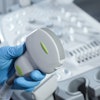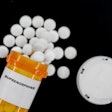Dental patients may not have to give up coffee or tea during chlorhexidine (CHX) treatment to avoid tooth discoloration if they drink the beverages with some milk, according to a research team from the Fraunhofer Institute for Microstructure of Materials and Systems IMWS.
Additionally, dentists should recommend that patients using the antiseptic mouth rinse consistently use toothpaste to brush their teeth and to leave as much time as possible between using the mouthwash and eating or drinking to avoid tooth staining, the authors said in a Fraunhofer press release dated January 2.
“It was interesting to observe that by diluting black tea and coffee with milk, the structure of the resulting layer of discoloration changes and becomes significantly less durable,” Dr. Sandra Sarembe, a Fraunhofer IMWS researcher, said in the release.
For years, CHX has been prescribed for patients with gum disease before or after certain dental procedures. Though it decreases bacteria in the mouth, the rinse can cause tooth staining after eating and drinking.
To examine the impact of different beverages on potential discoloration during CHX treatment, an in vitro study was conducted. The team used a scanning electron microscope to examine the effects of 11 beverages with varying pH levels and colors, including coffee and black tea with and without milk.
 After drinking pure black tea (a) during CHX treatment, significantly stronger staining can be seen under the scanning electron microscope in comparison to drinking the beverage diluted with milk (b). Images and caption courtesy of Fraunhofer IMWS/Haleon.
After drinking pure black tea (a) during CHX treatment, significantly stronger staining can be seen under the scanning electron microscope in comparison to drinking the beverage diluted with milk (b). Images and caption courtesy of Fraunhofer IMWS/Haleon.
They exposed dental crowns to artificial saliva, 0.2% CHX mouthwash, and the beverages over 28 cycles, simulating a 14-day CHX usage period, and they also replicated daily teeth cleaning with water and toothpaste using a toothbrushing simulator.
The crowns exposed to black tea and coffee showed more significant staining than those exposed to beverages diluted with milk, according to the release.
“They should ideally always add milk when drinking tea or coffee,” according to the release.




















